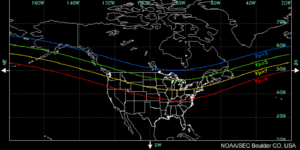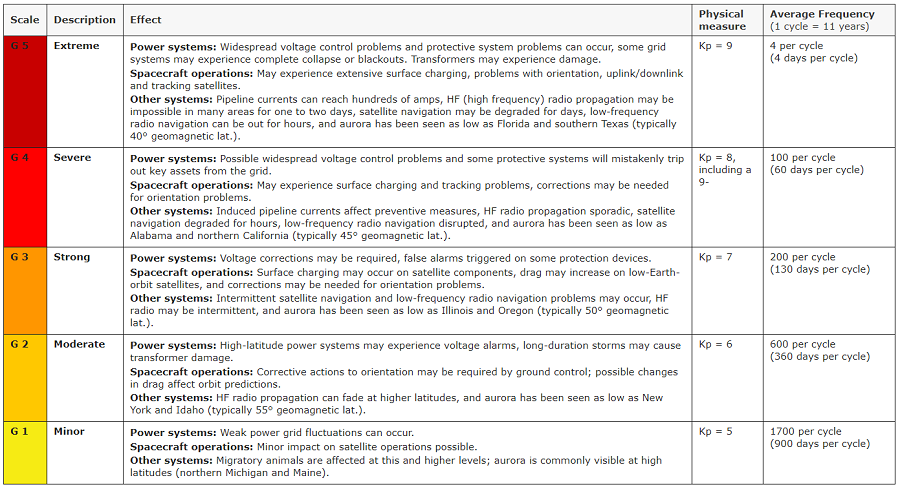
A severe geomagnetic storm is blasting Earth, triggering an intense display of the aurora or “Northern Lights” over parts of the country that rarely see them. According to the National Weather Service’s Space Weather Prediction Center (SWPC), current solar wind measurements suggest storm conditions will continue through the night. As a result, the SWPC continues a Geomagnetic Storm Warning for “Strong” or higher geomagnetic storm conditions through at least 2:00 am ET.

Due to the unusual intensity of this storm, the aurora is moving further equatorward, setting-up brilliant colorful light shows over places like Virginia, Arkansas, and Northern California.
The probability and location of aurora displays is based on the Kp index of the storm. The K-index, and by extension the Planetary K-index, are used to characterize the magnitude of geomagnetic storms. The SWPC says that Kp is an excellent indicator of disturbances in the Earth’s magnetic field and is used by SWPC to decide whether geomagnetic alerts and warnings need to be issued for users who are affected by these disturbances. Beyond signifying how bad a geomagnetic storm’s impact can be felt, the Kp index can also help indicate how low, latitude-wise the aurora will be. The Kp reading was as high as 8 earlier this evening and dipped but is back at 8 as of press time.
Beyond spectacular aurora, Geomagnetic Storms can also create other problems. Geomagnetic storms are rated on a 1-5 scale by the SWPC, with 1 considered minor and 5 considered extreme. Geomagnetic storms can disrupt electronics and electrical systems and interfere with spacecraft and satellite communication. Based on the intensity of today/tonight’s event, the SWPC says “manageable effects possible to power grid, satellite ops, and GPS”; and unlike previous geomagnetic storms, due to the intensity of this one, such impacts are possible deep into the Continental United States. Today’s storm is rated as a G4 event.

While these solar events can help illuminate the sky with stunning aurora, they can also do considerable harm to electronics, electrical grids, and satellite and radio communications, especially if conditions even more severe than this evening’s are reached.
A 1859 incident, which occurred on September 1-2 in 1859, is also known as the “Carrington Event.” This event unfolded as powerful geomagnetic storm struck Earth during Solar Cycle 10. A CME hit the Earth and induced the largest geomagnetic storm on record. The storm was so intense it created extremely bright, vivid aurora throughout the planet: people in California thought the sun rose early, people in the northeastern U.S. could read a newspaper at night from the aurora’s bright light, and people as far south as Hawaii and south-central Mexico could see the aurora in the sky.
Incredible colorful aurora is on display in places that don’t often see it, such as this location in central Virginia tonight:#VAwx https://t.co/rWrzQzOD38
— the Weatherboy (@theWeatherboy) April 24, 2023
The event severely damaged the limited electrical and communication lines that existed at that time; telegraph systems around the world failed, with some telegraph operators reporting they received electric shocks.
A June 2013 study by Lloyd’s of London and Atmospheric and Environmental Research (AER) in the U.S. showed that if the Carrington event happened in modern times, damages in the U.S. could exceed $2.6 trillion, roughly 15% of the nation’s annual GDP.
While typically known for their weather forecasts, the National Oceanic and Atmospheric Administration (NOAA) and its National Weather Service (NWS) is also responsible for “space weather.” While there are private companies and other agencies that monitor and forecast space weather, the official source for alerts and warnings of the space environment is the Space Weather Prediction Center (SWPC). The SWPC is located in Boulder, Colorado and is a service center of the NWS, which is part of NOAA. The Space Weather Prediction Center is also one of nine National Centers for Environmental Prediction (NCEP) as they monitor current space weather activity 24/7, 365 days a year.